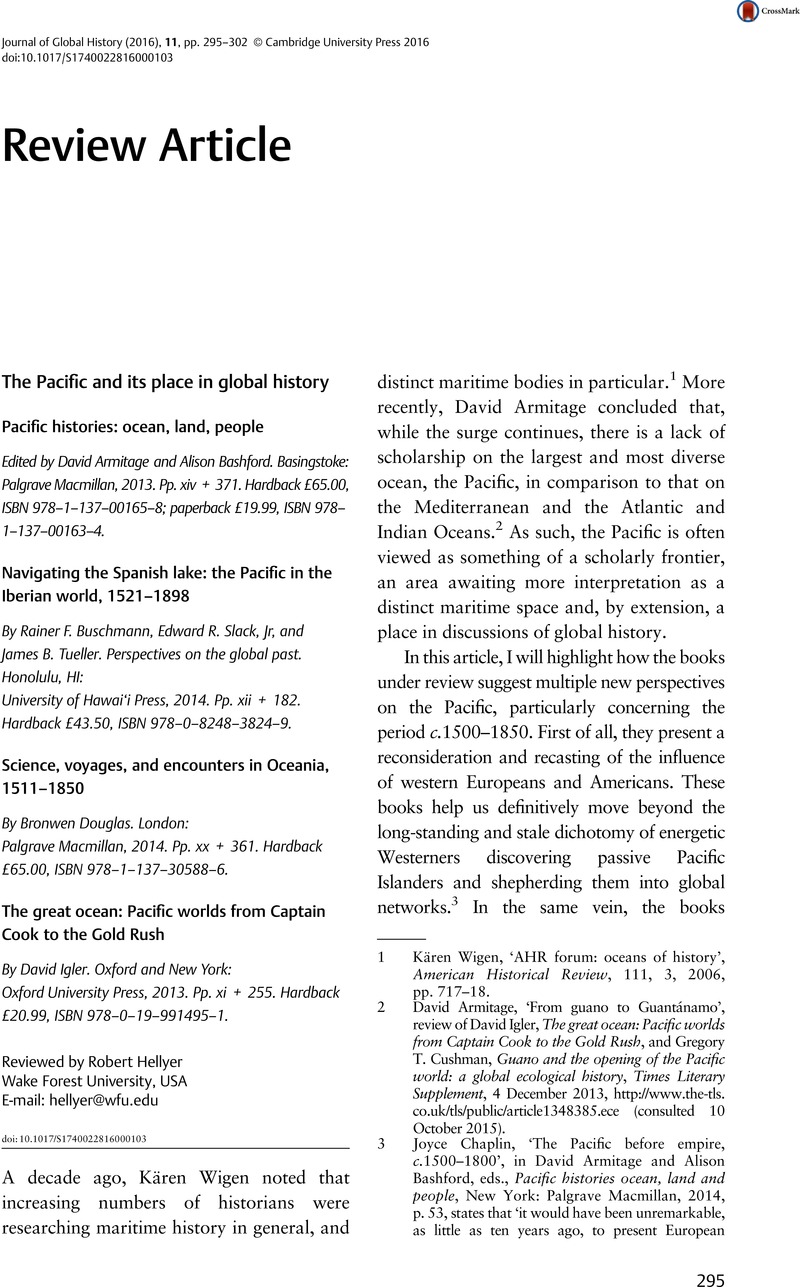No CrossRef data available.
Article contents
The Pacific and its place in global history - Pacific histories: ocean, land, people Edited by David Armitage and Alison Bashford. Basingstoke: Palgrave Macmillan, 2013. Pp. xiv + 371. Hardback £65.00, ISBN 978–1–137–00165–8; paperback £19.99, ISBN 978–1–137–00163–4. - Navigating the Spanish lake: the Pacific in the Iberian world, 1521–1898 By Rainer F. Buschmann Edward R. SlackJr, and James B. Tueller. Perspectives on the global past. Honolulu, HI: University of Hawai‘i Press, 2014. Pp. xii + 182. Hardback £43.50, ISBN 978–0–8248–3824–9. - Science, voyages, and encounters in Oceania, 1511–1850 By Bronwen Douglas. London: Palgrave Macmillan, 2014. Pp. xx + 361. Hardback £65.00, ISBN 978–1–137–30588–6. - The great ocean: Pacific worlds from Captain Cook to the Gold Rush By David Igler. Oxford and New York: Oxford University Press, 2013. Pp. xi + 255. Hardback £20.99, ISBN 978–0–19–991495–1.
Published online by Cambridge University Press: 03 June 2016
Abstract

- Type
- Review Article
- Information
- Copyright
- Copyright © Cambridge University Press 2016
References
1 Wigen, Kären, ‘AHR forum: oceans of history’, American Historical Review, 111, 3, 2006, pp. 717–718CrossRefGoogle Scholar.
2 David Armitage, ‘From guano to Guantánamo’, review of David Igler, The great ocean: Pacific worlds from Captain Cook to the Gold Rush, and Gregory T. Cushman, Guano and the opening of the Pacific world: a global ecological history, Times Literary Supplement, 4 December 2013, http://www.the-tls.co.uk/tls/public/article1348385.ece (consulted 10 October 2015).
3 Chaplin, Joyce, ‘The Pacific before empire, c.1500–1800’, in David Armitage and Alison Bashford, eds., Pacific histories ocean, land and people, New York: Palgrave Macmillan, 2014, p. 53CrossRefGoogle Scholar, states that ‘it would have been unremarkable, as little as ten years ago, to present European ‘discovery’ of the Pacific as a chapter in a story of some kind of incremental progress’.
4 Spate, O. H. K., The Spanish lake: the Pacific since Magellan, vol. 1, Canberra: Australian National University Press, 2004, p. ixCrossRefGoogle Scholar.
5 I have also explored this aspect of the early modern Pacific economy in the pages of this journal: Hellyer, Robert, ‘The West, the East, and the insular middle: trading systems, demand, and labour in the integration of the Pacific, 1750–1875’, Journal of Global History, 8, 3, 2013, pp. 391–413CrossRefGoogle Scholar.
6 In 1820, East Asia was the most populous region in the Pacific Rim, with a population of 427 million people, compared with 23 million combined in Australasia and the Americas and 34 million in Southeast Asia. Sugihara, Kaoru, ‘The economy since 1800’, in Armitage and Bashford, Pacific histories, p. 167Google Scholar.
7 Menzies, Gavin, 1421: the year China discovered America, New York: William Morrow, 2003Google Scholar. Based on scant evidence, Menzies argues that Chinese mariners mapped and explored the Pacific and ‘discovered’ the Americas before Columbus. Finlay, Robert, ‘Review: how not to (re)write world history: Gavin Menzies and the Chinese discovery of America’, Journal of World History, 15, 2, 2004, pp. 229–242CrossRefGoogle Scholar, precisely outlines the flaws and exaggerations of Menzies’ monograph.




